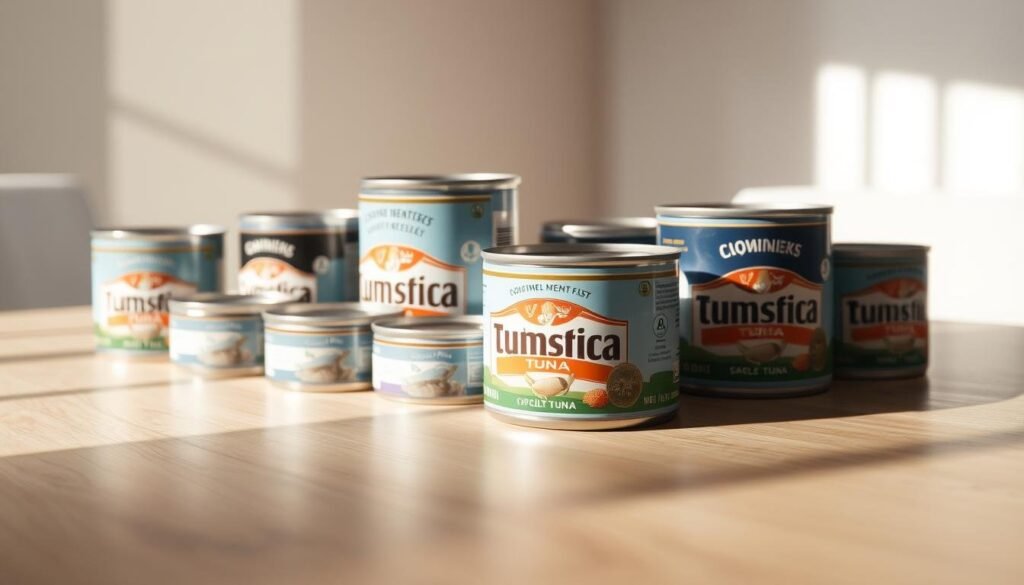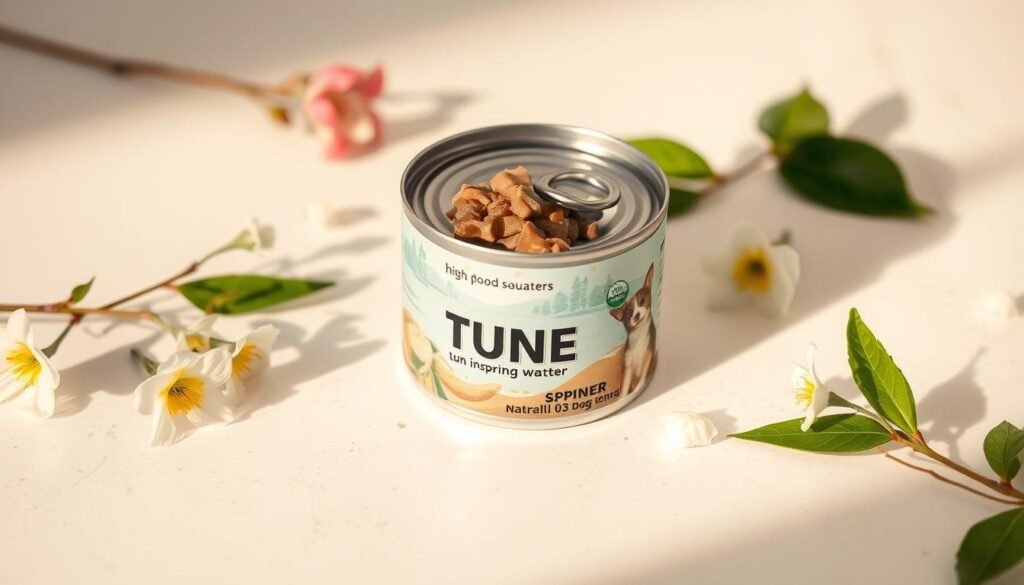If you’re a dog owner, you’re always looking for healthy food for your pet. You might be thinking, “Can dogs eat canned tuna in spring water?” This article will look into whether it’s safe and good for your dog.
Choosing the right food for your dog is key to their health. While tuna can be good, it’s important to know the risks and how to give it to them safely. We’ll talk about the good and bad sides, helping you make smart choices for your dog’s diet.
Contents
- 1 The Safety of Canned Tuna in Spring Water for Dogs
- 2 Potential Benefits of Feeding Dogs Canned Tuna
- 3 Risks and Concerns: Can Dogs Eat Canned Tuna in Spring Water Safely?
- 4 How Much Canned Tuna Can Dogs Safely Consume?
- 5 Preparing and Serving Canned Tuna to Dogs
- 6 Conclusion
- 7 FAQ
- 7.1 Is canned tuna in spring water safe for my dog to eat?
- 7.2 What are the benefits of feeding my dog canned tuna in spring water?
- 7.3 How much canned tuna can I safely feed my dog?
- 7.4 What are the risks associated with feeding my dog canned tuna?
- 7.5 How should I prepare and serve canned tuna to my dog?
- 7.6 Can I feed my dog canned tuna daily?
- 7.7 Are there any specific types of canned tuna that are safer for my dog?
The Safety of Canned Tuna in Spring Water for Dogs
As a dog owner, it’s important to know if canned tuna is safe for your pet. Canned tuna can be good for your dog’s diet. But, you need to know about the different types and their health effects.
Types of Canned Tuna
Canned tuna has different forms, and the type matters for your dog’s health. Tuna canned in spring water is safer than tuna in oil because it has less fat.
When picking canned tuna for your dog, look at the label. Check for added salt or harmful ingredients. Some tuna may have mercury, which is toxic to dogs.
| Type of Canned Tuna | Packing Medium | Added Ingredients | Safety for Dogs |
|---|---|---|---|
| Skipjack Tuna | Spring Water | No added salt | Generally safe |
| Albacore Tuna | Oil | High salt content | Less safe due to high fat and salt |
| Yellowfin Tuna | Spring Water | Low salt | Safe, but check mercury levels |
To keep your dog safe, pick canned tuna low in mercury and without harmful additives.
Feeding your dog canned tuna in small amounts can be healthy. Just make sure to choose the right type and be aware of the risks.
Potential Benefits of Feeding Dogs Canned Tuna
Canned tuna is packed with protein, which is great for your dog’s health. It’s full of omega-3 fatty acids. These help keep your dog’s skin, coat, and heart in top shape.
One big benefit of canned tuna for dogs is its nutritional value. It’s not just protein; it also has essential fatty acids. These can reduce inflammation and make your dog’s skin and coat healthier.
Canned tuna is also low in saturated fats and calories. This makes it a healthy treat for dogs. But remember, dogs need different nutrients than people. So, canned tuna should not be a big part of their diet.
Nutritional Comparison of Canned Tuna with Other Dog Foods
| Food Type | Protein Content | Omega-3 Fatty Acids | Saturated Fat Content |
|---|---|---|---|
| Canned Tuna | High | High | Low |
| Kibble | Moderate | Low | Moderate |
| Fresh Salmon | High | High | Low |
When thinking about adding canned tuna to your dog’s diet, consider its benefits. The table above shows how canned tuna stacks up against other dog foods. It highlights its nutritional strengths.
To get the most out of canned tuna for your dog, serve it in small amounts. Make sure it’s part of a balanced diet. Always talk to a vet before changing your dog’s food.
Risks and Concerns: Can Dogs Eat Canned Tuna in Spring Water Safely?
As a dog owner, it’s key to know the risks of giving your dog canned tuna in spring water. It can be a healthy snack, but there are dangers, especially mercury.
Risks Associated with Mercury
Mercury is harmful and can build up in the body, causing health problems. Canned tuna has mercury, but the amount varies. Bluefin and yellowfin tuna have more mercury than skipjack and canned light tuna.
To reduce risks, pick tuna with less mercury and only give it in small amounts. Here’s a look at mercury levels in different tuna types:
| Type of Tuna | Mercury Level |
|---|---|
| Bluefin | High |
| Yellowfin | Moderate to High |
| Skipjack | Low |
| Canned Light Tuna | Low |
Feeding your dog tuna in small amounts and choosing low-mercury types can help. Knowing the signs of mercury poisoning is also important. These include loss of coordination, tremors, and seizures.
By being careful and informed, you can safely give your dog canned tuna as an occasional treat. Always talk to your vet before adding human foods to your dog’s diet.
How Much Canned Tuna Can Dogs Safely Consume?
Figuring out how much canned tuna is safe for your dog depends on a few things. These include their size, age, and health. A good rule of thumb is to keep canned tuna under 10% of their daily calories.
If your dog needs 500 calories a day, they can have up to 50 calories from tuna. This is important to avoid health problems. Start with small amounts and watch how they react to prevent stomach issues.

Think about your dog’s specific needs when deciding on tuna. A bigger dog might handle more, but always stay within the 10% limit. Remember, tuna should be a treat, not a main meal.
- Keep an eye on your dog’s health and adjust tuna amounts as needed.
- Talk to your vet to find the best diet for your dog.
- Choose tuna in spring water to avoid extra salts or oils.
Being careful with how much tuna you give your dog helps keep them healthy. Make sure it fits their nutritional needs.
Preparing and Serving Canned Tuna to Dogs
To make sure your dog enjoys canned tuna safely, proper preparation is crucial. Serving canned tuna to dogs can be a nutritious and healthy treat if done right.
First, drain the liquid from the canned tuna. Rinsing the tuna under cold water can also help remove any excess salt. This makes it a healthier option for your dog. After rinsing, you can mix the tuna with your dog’s regular food or serve it as a treat on its own.
When serving canned tuna to your dog, choose a plain, unflavored variety. This avoids any potential allergens or irritants. It’s also crucial to introduce canned tuna gradually into your dog’s diet. This helps monitor for any adverse reactions.
- Drain the liquid from the canned tuna.
- Rinse the tuna under cold water to remove excess salt.
- Serve plain, unflavored tuna to avoid potential allergens.
- Mix tuna with regular food or serve as a treat.
- Introduce tuna gradually to monitor for adverse reactions.
Nutritional Comparison
| Nutrient | Canned Tuna in Spring Water | Regular Dog Food |
|---|---|---|
| Protein | High | Moderate to High |
| Fat | Low to Moderate | Moderate |
| Sodium | Variable (depending on salt content) | Moderate |
By following these guidelines and being mindful of the nutritional content, you can safely serve canned tuna to your dog. It can be an occasional treat or dietary supplement.
Conclusion
Feeding your dog canned tuna in spring water can be safe and healthy if done right. It’s important to know the good and bad sides to make smart choices for your dog’s diet.
Canned tuna can be a great treat for dogs, but remember the risks. Always talk to your vet before adding it to your dog’s meals.
Knowing the rules and being careful can help your dog enjoy tuna safely. So, can dogs eat canned tuna in spring water? Yes, but do it with thought and in small amounts.
FAQ
Is canned tuna in spring water safe for my dog to eat?
Canned tuna in spring water is usually safe for dogs in small amounts. Always check the label for added salt or harmful ingredients.
What are the benefits of feeding my dog canned tuna in spring water?
Canned tuna is rich in protein and omega-3 fatty acids. These nutrients support your dog’s health, including their skin, coat, and heart.
How much canned tuna can I safely feed my dog?
Feed no more than 10% of your dog’s daily calories from tuna. For a 500-calorie diet, give up to 50 calories of tuna.
What are the risks associated with feeding my dog canned tuna?
The main risk is mercury in tuna. Mercury is toxic and can harm your dog over time.
How should I prepare and serve canned tuna to my dog?
Drain the liquid and rinse the tuna under cold water to remove salt. Mix it with your dog’s food or serve as a treat. Choose plain, unflavored tuna to avoid allergens.
Can I feed my dog canned tuna daily?
No, it’s best not to feed tuna every day. Limit it to avoid adverse reactions.
Are there any specific types of canned tuna that are safer for my dog?
Yes, skipjack and canned light tuna have less mercury than bluefin and yellowfin. Opt for low-mercury tuna to reduce risks.

Derrick Wilcox is a certified canine behaviorist with over 12 years of experience at Happy Paws Animal Clinic and Pawsitive Training Center, helping pet owners ensure safer, healthier, and happier lives for their dogs.



